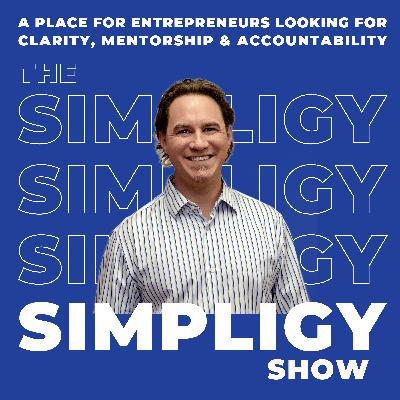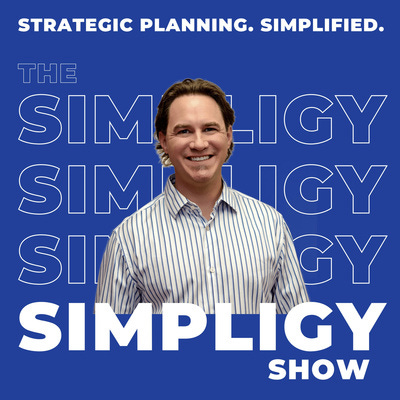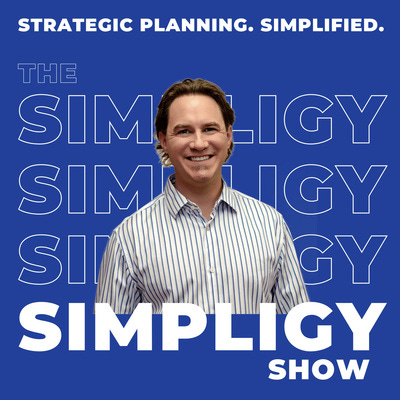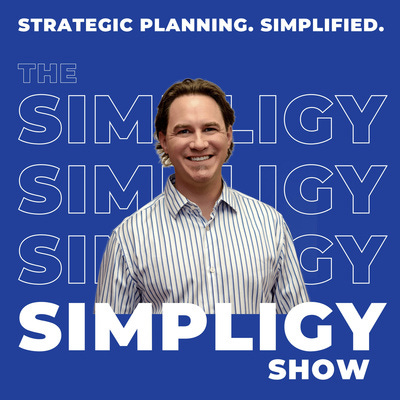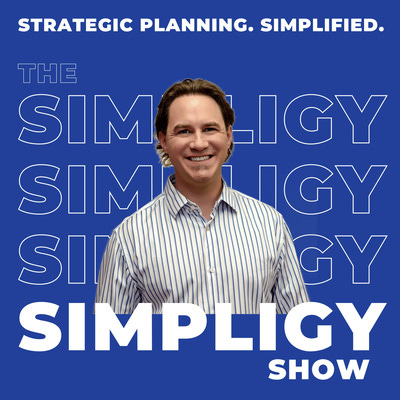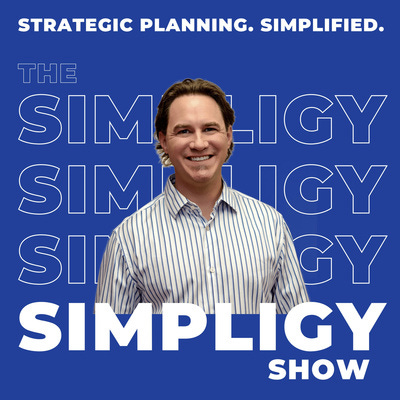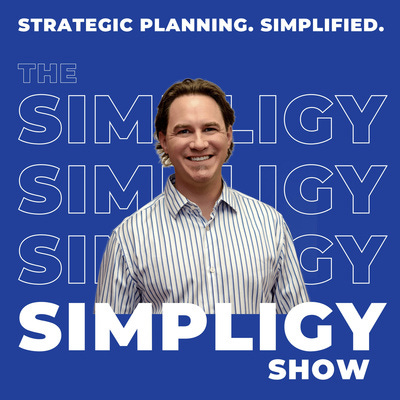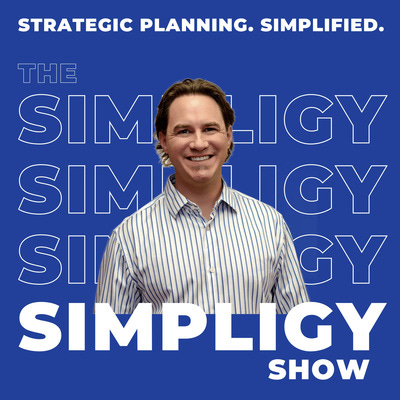Discover The Simpligy Show
The Simpligy Show

The Simpligy Show
Author: Bruce White | Mentor. Coach. Strategist.
Subscribed: 0Played: 0Subscribe
Share
© Bruce White
Description
Success Begins With Getting You Unstuck, Simplifying Your Business & Stabilizing Your Revenue. We'll Start There.
simpligy.substack.com
simpligy.substack.com
19 Episodes
Reverse
What if you could lead a strategy engagement without your mind just arbitrarily shutting you down?In this episode, I want to talk about how fear, or overwhelm, or anxiety, or overthinking can stall the very, very best people — the people most well-suited to being strategists — and prevent them from even making a start. Along with some of the things that we can do to get around that so that we give ourselves the best opportunity to make moves forward and take part in a vocation or a career that we are uniquely suited to, and one within which we can be incredibly successful.Want to join the discussion? Hear more like this?Join me in the Simpligy Collective, the free community for leaders and strategists, the thinkers, analytical personalities, and creatively frustrated who know there's more freedom and enjoyment available within your business but don't want to reinvent the wheel with every decision.It's free. I hope to see you on the inside: https://simpligycollective.com This is a public episode. If you would like to discuss this with other subscribers or get access to bonus episodes, visit simpligy.substack.com
Hey Strategists, In this episode, I’m going to talk about the three different types of thinking for strategists and the superpower that you already have at your fingertips if you just start using it. As strategists, our strength is helping clients - or even our own businesses - identify and understand either new problems to be solved or new opportunities to be exploited. And, the quality of the thinking that goes into such choices is the most important element of the quality and success of a company’s strategy. But, the problem is that there are several different ways of thinking that we typically employ when trying to think strategically. Each is valuable, and important in certain circumstances but, the wrong two are the ones most utilized when applying "strategic" thinking in a business environment. Want to chat more about this or other strategy and facilitation questions? Join me in the https://simpligycollective.com/ The Simpligy Collective gives entrepreneurs, business leaders, and strategists the tools, processes, and confidence to facilitate strategy consulting as a strategic partner and, instead of responding to client demands, advise and direct them. This is a public episode. If you would like to discuss this with other subscribers or get access to bonus episodes, visit simpligy.substack.com
On the surface, that seems totally contradictory. We're introverts. We don't want community, right!?Well, in reality, the exact opposite is true. We ALL need community, it's just that, as introverts, we experience it differently, and we need some more control over when and how to interact.And, the good news is, we have amazing community opportunities that actually do give us total control over our own energy and how much of it we allow to be controlled by them.And, if you're looking for a community, and you don't know where to start, I humbly invite you to join mine, the Simpligy Collective. It's free, there's no hard sells or anything like that, just an environment where I want to give real value to people who can benefit from it.You don't have to be a member of any of our programs, the Simpligy Collective is designed to be a home for the thinkers, the analytical personalities, and the creatively frustrated entrepreneurs and strategy consultants looking for perspective and direction to help you plan and move to the right next steps for your business.You can learn more and join for free at https://simpligycollective.comI hope to see you on the inside. This is a public episode. If you would like to discuss this with other subscribers or get access to bonus episodes, visit simpligy.substack.com
Hey strategists, I’ve got a special one for you today, I’m going to show you how to assemble your Brand's Origin Story step by step.We'll go through the four distinct elements of the story, show you where to get the content for each, and even give you an example for each step to follow along. Break out your digital whiteboard software, your text document, or even a simple notepad, and let's get going.-----------And if you want to learn how to lead your clients through a complete Messaging Sprint, and become a brand and messaging strategist, you'll want to grab our Canadian Thanksgiving bundle:The Brand Sprint Blueprint and the Messaging Sprint Kit bundle for $500 off the already discounted bundle price, until Monday, October 11th, 2021 (Canadian Thanksgiving).Use the coupon code: GiveThanks here to grab the bundle for the cheapest it will ever be offered.>>Click here to get your $500 discount before it's too late. This is a public episode. If you would like to discuss this with other subscribers or get access to bonus episodes, visit simpligy.substack.com
In this episode, I'd like to talk to you about how important is it for you as a strategist - whether that’s you as the leader of your organization or you’re selling and facilitating strategy for your clients - the importance of having your own business coach or business mentor.There are a lot of people offering this type of service and, of course, you have resources that you can take advantage of without signing up with the coach, like YouTube and blogs etc.But, at some point, you’re going to get to a question that can’t be answered in a YouTube comment section and that’s an interesting inflection point for most people.Want to chat more about this or other strategy and facilitation questions? Join me in the https://simpligycollective.com/ This is a public episode. If you would like to discuss this with other subscribers or get access to bonus episodes, visit simpligy.substack.com
Overthinking is what’s stopping you becoming a great strategistBut, overthinking is also what MAKES you a great strategist.What you need to do is harness that overthinking into a problem-solving process, rather than just letting it sabotage you from ever moving forward.And that’s what’s so exciting to me because, all of those reasons that your mind is volunteering, all of that overthinking, all of that follow down the rabbit hole that your mind is doing, is actually proving your abilities as a strategist.In fact, I think that overthinking is probably the number one skill a strategist can have.The trick is to redirect that overthinking into solving the problem.That’s what we’re doing as strategists. We’re identifying and solving problems in patterns of data that others can’t see.A stubborn overthinker is born for that! This is a public episode. If you would like to discuss this with other subscribers or get access to bonus episodes, visit simpligy.substack.com
In this episode, I want to give you all the details on how to write your Value Proposition today.I know these can feel overwhelming because it's so easy to second guess every little thing, but you can assemble the parts to this and have a finished version, ready for testing, today.I originally discovered this format in a book called, Crossing the Chasm by Geoffrey Moore but, it’s been used and modified several times for both Value Propositions and Positioning Statements by different people over the years.For {target} who {statement of the need or opportunity}, {Name} is {product category} that {statement of benefit}Typically, when we lead a client through this, it’s later in the process so, there are certain elements that we’ve already gone over, like brand values, personality, ideal client definitions, etc.If you don't have those elements handy, though, don't worry. It's still worth the exercise to uncover where your own brand knowledge is lacking.And, if you're doing this for a client, this is a perfect start to your roadmap of required strategic work!Here's the worksheet. This is a public episode. If you would like to discuss this with other subscribers or get access to bonus episodes, visit simpligy.substack.com
We “create” solutions and develop understanding in every aspect of our life: career, relationships, environment, etc. Every waking moment and even in our dreams. So, creativity is a natural part of our life. But, how do you develop it?Tune in to find out in this episode. This is a public episode. If you would like to discuss this with other subscribers or get access to bonus episodes, visit simpligy.substack.com
The biggest mistake in product development is undoubtedly developing a product or service based on a big idea. And, the problem with that process is that, an idea doesn’t understand the real user’s needs until it’s been rolled out and tested.So, it becomes this constant process of guessing and iteration.There are some processes that attempt to solve that issue, like a design sprint, but, even then, they are beginning from an idea.In this episode, I want to talk about what to do instead to begin from the market’s real needs and then develop the idea that will lead to the solution for those problems.LINKS:Review Mining Tutorial: https://youtu.be/gte7rIA8aFYProduct Sprint Blueprint Early Access: https://productsprintblueprint.comSprint Masters Toolkit: https://sprintmasterstoolkit.comSimpligy: https://simpligy.com This is a public episode. If you would like to discuss this with other subscribers or get access to bonus episodes, visit simpligy.substack.com
What if you already have the answers?In this episode, I want to talk about getting out of your business. Not for the usual reasons of mental health, or stress management — all of which is vitally important — but for actual business growth.This is how you get your head out the way, stop comparisons and imposter syndrome, stop the "what if's" and the choices, and learn to rely on the answers you already have.Oh, and it's also my 50th birthday :) This is a public episode. If you would like to discuss this with other subscribers or get access to bonus episodes, visit simpligy.substack.com
Branding will often be explained as a long-term commitment that results from thousands of interactions between a customer and the brand’s touchpoints over time.But, ever since the phrase, “touchpoints” started being used, branding has devolved into making sure all your marketing and sales materials look the same and have the right logo. It became a design problem.But it’s not a design problem, branding is a behavioral question.When it's working, it just feels right. And that can only be achieved by being authentic in your brand. It’s not about making a pretty logo or a clever tagline, it’s about developing a brand character that will direct your company’s actions and behaviors in such a way that you appeal to those who align with you.In this episode, I’m going to explain why it works and why it’s so important to stop asking design to influence your brand’s ability to connect. This is a public episode. If you would like to discuss this with other subscribers or get access to bonus episodes, visit simpligy.substack.com
So you've uncovered your specialty, simplified your business and now you're trying to scale.But now you're running into the problem of clients always trying to haggle on price.Because, if you've done your positioning strategy correctly, you've very deliberately increased your prices to attract a higher value client base.In this episode, I'm going to go through exactly why this is happening, how to get around it, and why it's a very good thing. This is a public episode. If you would like to discuss this with other subscribers or get access to bonus episodes, visit simpligy.substack.com
Most of the time, when you're running strategic planning for a client, they're going to be pretty certain of who they're competing with. But, every now and then, you'll run across a client who either doesn't know, or they think they're competing with every other business in their vertical.This is especially true now that we no longer live in a "local competition" world. It's no longer a matter of Googling, "Hair stylist, Austin, TX" for example.In this episode, I'm going to show you some places you can go to uncover your client's competition when even they don't know. This will give you a list you can take back to your client to refresh their memory, narrow down the reality, and give you a starting point to do your actual competitive analysis. Because you can't start that without knowing who you're analyzing! This is a public episode. If you would like to discuss this with other subscribers or get access to bonus episodes, visit simpligy.substack.com
In this episode, I’m going to talk about eliminating scope creep because that's kind of the biggest profit and fun sucker in the strategic services industry.So, if you’re looking for a better way to keep your projects under control and within budget, and stop having to move the goalposts every five seconds, I’m going to go through the most important and, often the most forgotten exercise you can do with your client to make sure you keep everything right on track.Grab our free training on how to define your perfect audience for your brand. This is a public episode. If you would like to discuss this with other subscribers or get access to bonus episodes, visit simpligy.substack.com
Everybody knows that some clients are better than others …And that if you want to attract higher ticket prospects, you’re going to have to close them with some form of human interaction.But, you never, ever, ever want to talk to anyone in a sales environment unless they know: What you do. How much you charge, and they Meet your ideal client criteria.Otherwise, you’re always going to be chasing a maybe.And there’s a FORMULA for switching that perspective.Here’s how it works…Step 1: MirroringThis is just a simple way of saying, "we need to understand who our client is and what their value is to us" and then, simply demonstrating through our actions that we are on the same level as them.And this is where a lot of strategists get stuck because they’re still thinking of the customer’s money as the prize — so they create this imaginary “status” separation between them and their clients, which of course results in either taking a subservient stance to that client, and giving the client all the power, OR WORSE, only taking on clients who really don’t fit their ideal client criteria.Step 2: EvaluationEven if you find a bunch of new clients who all fit your pricing, they won’t all be the right fit for your business.They also need to demonstrate that they will be easy to work with and manageable, as in, “willing to work within your processes and able to be managed” from a project/client perspective.Step 3: ClosingThe prescription to fix what ails them. Using everything you've gathered from them on the call. Of course, they’re going to say yes, they just designed the plan WITH you! You didn’t just pull this stuff out of a hat, it came from them. Get the worksheet here. This is a public episode. If you would like to discuss this with other subscribers or get access to bonus episodes, visit simpligy.substack.com
Today, I wanted to talk about when and how creative service consultancies or creative service businesses can switch to value-based pricing.And the main thing we're going to focus on is the power of specializing and productizing for the creative industry.Here's the thing: A customized services business is not built for scale. A company that is built for scale has set processes, prices, and products. And, the longer you stay as a customized services business, the harder it is to get to stage 2, which involves value-based pricing, specializing, and scalability. Which is about strategy and not tactics.The reality is, your goal should be to do less, but more significant work, with much higher profit margins, which becomes possible when your systems don’t need to be adjusted for each client, and you’re providing a very specific result or a solution to a very specific problem.Got questions or comments? Find this episode on our website at https://buildingbrandsforclients.com/ This is a public episode. If you would like to discuss this with other subscribers or get access to bonus episodes, visit simpligy.substack.com
If you've ever wanted to sell strategy services but got in your own way because you don't like the idea of "selling," I'm going to give you the simplest approach to selling that will take all the "icky" out of the process and let you just get down to being valuable. This is a public episode. If you would like to discuss this with other subscribers or get access to bonus episodes, visit simpligy.substack.com
Have you been trying to move into a value-based pricing model, and you’re feeling like you can't get your customers to change their perception of you from creative supplier to business partner? In this episode, I’m going to tell you why your discovery process is based on flawed thinking and is never going to get you better clients and what you should be doing instead.Remember, if your prospects are coming to you for deliverables and you want to pivot the conversation from creative deliverables to strategy, I’ve created a FREE Masterclass on how to: explain strategy to potential clients, how to Pivot them away from deliverables, how to make sure they can afford you, and how to close them into a strategy sale insteadSimply by being more valuable.So, if that interests you, it’s free and it’s available now: http://howtotalkaboutbranding.comI’ve also included a download with the first contact response and the conversation script with responses to sticking points and roadblocks, so go ahead and you can learn how to pivot deliverable clients to strategy clients. This is a public episode. If you would like to discuss this with other subscribers or get access to bonus episodes, visit simpligy.substack.com
Depending on your perspective, the good news is that, no, you do not need to be a designer to be a brand strategist. I want to show you some of the traits that good brand strategists share and you might be surprised to find that, what you perceived as weaknesses are actually strengths. See, brand strategy is one of those elusive industries where those of us who have wide-ranging abilities (but have worried about not feeling like we have a real, one thing that we specialize in), can feel right at home and, in fact, can excel. So, who should be a brand strategist? Or, more to the point, who’s most likely to be successful as a brand strategist and absolutely love coming to work every day, because, isn’t that the point? There’s a big difference between choosing strategy because you’re sick of bad creative customers versus choosing strategy because it’s an endlessly enjoyable opportunity. Listen to the episode to see how your unique abilities fit as a strategist.And if your prospects are coming to you for deliverables and you want to pivot the conversation from creative deliverables to strategy, I’ve created a FREE Masterclass on how to: explain strategy to potential clients, how to Pivot them away from deliverables, how to make sure they can afford you, and how to close them into a strategy sale instead Simply by being more valuable. So, if that interests you, it’s free and it’s available now: http://howtotalkaboutbranding.com I’ve also included a download with the first contact response and the conversation script with responses to sticking points and roadblocks, so go ahead and you can learn how to pivot deliverable clients to strategy clients. This is a public episode. If you would like to discuss this with other subscribers or get access to bonus episodes, visit simpligy.substack.com


